Why Skiving Hydraulic Hose is the Secret to a Perfect Seal Every Time
Share this Post to earn Money ( Upto ₹100 per 1000 Views )

In the world of hydraulic systems, where high-pressure fluid dynamics meet the mechanical force of heavy machinery, achieving a reliable and leak-proof seal is paramount. Whether in industrial applications, construction equipment, or agricultural machinery, the integrity of hydraulic connections is critical to the performance, safety, and longevity of the system. One of the most effective techniques to ensure such integrity is skiving the hydraulic hose—a process that, though often overlooked, plays a crucial role in creating the perfect seal every time.
The Importance of a Perfect Seal in Hydraulic Systems
Hydraulic systems rely on the seamless transmission of power through fluid under pressure. This fluid must be contained within the system without leaks or losses, as even minor breaches can lead to significant issues such as decreased efficiency, potential equipment damage, or, in extreme cases, catastrophic failure. Therefore, the connections between hoses, fittings, and other components must be meticulously sealed to prevent fluid escape.
Creating a perfect seal involves more than simply tightening fittings. The hose itself must be prepared in a way that allows the fittings to bond securely and uniformly with the hose material. This is where skiving comes into play. Skiving hydraulic hoses is a process that removes a portion of the outer cover or both the cover and the inner tube, depending on the application. This preparation is essential to achieving a tight, leak-free connection that can withstand the demanding conditions typical in hydraulic systems.
What is Skiving and Why Does It Matter?
Skiving is a technique used in the preparation of hydraulic hoses before they are fitted with couplings or other connectors. It involves removing the outer layer (and sometimes the inner layer) of the hose and exposing the underlying reinforcement layer. This process ensures that when a fitting is applied, it can grip directly onto the reinforcement, rather than just the outer cover, creating a stronger and more reliable connection.
Why is this important?
The key to understanding the importance of skiving lies in the construction of hydraulic hoses. Hydraulic hoses are typically composed of multiple layers: an inner tube that carries the fluid, a reinforcement layer that provides strength, and an outer cover that protects the hose from environmental damage. When fittings are crimped onto the hose, a secure and leak-proof bond is essential between the fitting and the reinforcement layer. If the fitting is crimped onto the outer cover instead, the seal may not be as strong, leading to potential leaks or hose blowouts under pressure.
Wuxi Hydraforth Co., Ltd. understands the critical nature of this process. By offering hydraulic hoses that are specifically designed to be skived, along with providing the tools and expertise required to perform skiving accurately, Wuxi Hydraforth Co., Ltd. ensures that their customers can achieve the perfect seal every time.
The Skiving Process: A Step-by-Step Overview
The skiving process, while relatively straightforward, requires precision and attention to detail to ensure that the hydraulic hose is properly prepared for fitting installation. Below is a step-by-step overview of the skiving process as practiced by experts at Wuxi Hydraforth Co., Ltd.:
- Selecting the Hose and Fitting Combination: The first step in the skiving process is to select the appropriate hydraulic hose and fitting combination for the application. This selection is based on factors such as the working pressure, fluid compatibility, and environmental conditions.
- Determining the Skive Length: The next step is to determine the length of the hose that needs to be skived. This is typically specified by the fitting manufacturer and varies depending on the type of fitting being used.
- Using a Skiving Tool: A specialized skiving tool is used to remove the outer cover of the hose. For certain applications, the inner tube may also need to be skived. The skiving tool must be set to the correct depth and length to ensure that the appropriate amount of material is removed without damaging the reinforcement layer.
- Inspecting the Skived Hose: After skiving, the hose should be carefully inspected to ensure that the reinforcement layer is exposed uniformly and that there are no irregularities that could affect the seal. Any debris or remnants from the skiving process should be removed to prevent contamination.
- Installing the Fitting: Finally, the fitting is installed onto the skived hose. The exposed reinforcement layer allows the fitting to grip the hose securely, creating a strong and leak-proof seal. The fitting is then crimped or swaged onto the hose using a hydraulic press, completing the installation.
By following these steps, hydraulic professionals can ensure that the hoses are prepared to create the perfect seal every time, enhancing the performance and reliability of the hydraulic system.
The Benefits of Skiving Hydraulic Hose
Skiving hydraulic hoses offers several significant benefits that contribute to the overall effectiveness and safety of hydraulic systems. These benefits include:
- Enhanced Sealing Ability: The primary benefit of skiving is the improved sealing ability it provides. By exposing the reinforcement layer, skiving allows the fitting to bond more securely with the hose, reducing the risk of leaks and blowouts.
- Increased Hose Lifespan: A proper seal not only prevents leaks but also reduces wear and tear on the hose. This leads to an extended lifespan for the hose, reducing the frequency of replacements and associated downtime.
- Improved System Efficiency: Leaks in hydraulic systems can lead to loss of fluid and pressure, decreasing the overall efficiency of the system. By ensuring a leak-free seal, skiving helps maintain optimal system performance.
- Safety and Reliability: In high-pressure applications, the consequences of a hose failure can be severe. Skiving enhances the reliability of hydraulic connections, reducing the likelihood of accidents and ensuring the safety of both the equipment and the operators.
Skiving vs. Non-Skiving: Which is Right for Your Application?
While skiving offers numerous benefits, it is not always necessary for every application. The decision to skive or not to skive depends on several factors, including the type of hydraulic hose, the pressure rating, the type of fitting, and the specific application requirements.
Non-skive fittings are designed to create a secure seal without the need to remove the outer cover of the hose. These fittings can be a good option for applications where the hose cover provides sufficient protection and the risk of leaks is minimal. However, for high-pressure applications or situations where the highest level of reliability is required, skiving is often the preferred choice.
Wuxi Hydraforth Co., Ltd. offers both skiving and non-skiving hydraulic hoses, along with expert guidance on which option is best suited for each specific application. By providing a range of options, Wuxi Hydraforth Co., Ltd. ensures that their customers can find the perfect solution to meet their needs.
Skiving hydraulic hose is a powerful technique that can significantly enhance the performance, safety, and reliability of hydraulic systems. By removing the outer cover and exposing the reinforcement layer, skiving allows for a stronger bond between the hose and fitting, ensuring a perfect seal every time. This process is particularly important in high-pressure applications, where even minor leaks can lead to serious consequences.
Wuxi Hydraforth Co., Ltd. is a leader in the field of hydraulic hose manufacturing, offering a wide range of skiving hydraulic hoses and the expertise needed to perform skiving correctly. By choosing Wuxi Hydraforth Co., Ltd., customers can trust that they are receiving the highest quality products, designed to deliver superior performance and reliability in even the most demanding conditions.
As hydraulic systems continue to evolve and the demands placed on them increase, the importance of achieving a perfect seal will only grow. Skiving hydraulic hoses is one of the key steps in meeting this challenge, ensuring that hydraulic systems operate safely and efficiently, with minimal risk of leaks or failures. Whether you are in construction, agriculture, mining, or any other industry that relies on hydraulic systems, understanding and utilizing the power of skiving can make all the difference in your operations.
















